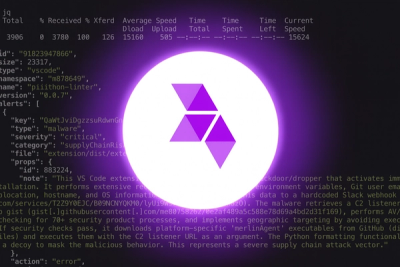
Product
Introducing Socket Scanning for OpenVSX Extensions
Socket now scans OpenVSX extensions, giving teams early detection of risky behaviors, hidden capabilities, and supply chain threats in developer tools.
@j2inn/comlink
Advanced tools
Comlink makes WebWorkers enjoyable. Comlink is a tiny library (1.1kB), that removes the mental barrier of thinking about postMessage and hides the fact that you are working with workers.
At a more abstract level it is an RPC implementation for postMessage and ES6 Proxies.
$ npm install --save comlink






Browsers without ES6 Proxy support can use the proxy-polyfill.
Size: ~2.5k, ~1.2k gzip’d, ~1.1k brotli’d
On mobile phones, and especially on low-end mobile phones, it is important to keep the main thread as idle as possible so it can respond to user interactions quickly and provide a jank-free experience. The UI thread ought to be for UI work only. WebWorkers are a web API that allow you to run code in a separate thread. To communicate with another thread, WebWorkers offer the postMessage API. You can send JavaScript objects as messages using myWorker.postMessage(someObject), triggering a message event inside the worker.
Comlink turns this messaged-based API into a something more developer-friendly by providing an RPC implementation: Values from one thread can be used within the other thread (and vice versa) just like local values.
main.js
import * as Comlink from "https://unpkg.com/comlink/dist/esm/comlink.mjs";
async function init() {
const worker = new Worker("worker.js");
// WebWorkers use `postMessage` and therefore work with Comlink.
const obj = Comlink.wrap(worker);
alert(`Counter: ${await obj.counter}`);
await obj.inc();
alert(`Counter: ${await obj.counter}`);
}
init();
worker.js
importScripts("https://unpkg.com/comlink/dist/umd/comlink.js");
// importScripts("../../../dist/umd/comlink.js");
const obj = {
counter: 0,
inc() {
this.counter++;
},
};
Comlink.expose(obj);
main.js
import * as Comlink from "https://unpkg.com/comlink/dist/esm/comlink.mjs";
// import * as Comlink from "../../../dist/esm/comlink.mjs";
function callback(value) {
alert(`Result: ${value}`);
}
async function init() {
const remoteFunction = Comlink.wrap(new Worker("worker.js"));
await remoteFunction(Comlink.proxy(callback));
}
init();
worker.js
importScripts("https://unpkg.com/comlink/dist/umd/comlink.js");
// importScripts("../../../dist/umd/comlink.js");
async function remoteFunction(cb) {
await cb("A string from a worker");
}
Comlink.expose(remoteFunction);
SharedWorkerWhen using Comlink with a SharedWorker you have to:
port property, of the SharedWorker instance, when calling Comlink.wrap.Comlink.expose within the onconnect callback of the shared worker.Pro tip: You can access DevTools for any shared worker currently running in Chrome by going to: chrome://inspect/#workers
main.js
import * as Comlink from "https://unpkg.com/comlink/dist/esm/comlink.mjs";
async function init() {
const worker = new SharedWorker("worker.js");
/**
* SharedWorkers communicate via the `postMessage` function in their `port` property.
* Therefore you must use the SharedWorker's `port` property when calling `Comlink.wrap`.
*/
const obj = Comlink.wrap(worker.port);
alert(`Counter: ${await obj.counter}`);
await obj.inc();
alert(`Counter: ${await obj.counter}`);
}
init();
worker.js
importScripts("https://unpkg.com/comlink/dist/umd/comlink.js");
// importScripts("../../../dist/umd/comlink.js");
const obj = {
counter: 0,
inc() {
this.counter++;
},
};
/**
* When a connection is made into this shared worker, expose `obj`
* via the connection `port`.
*/
onconnect = function (event) {
const port = event.ports[0];
Comlink.expose(obj, port);
};
// Single line alternative:
// onconnect = (e) => Comlink.expose(obj, e.ports[0]);
For additional examples, please see the docs/examples directory in the project.
Comlink.wrap(endpoint) and Comlink.expose(value, endpoint?, allowedOrigins?)Comlink’s goal is to make exposed values from one thread available in the other. expose exposes value on endpoint, where endpoint is a postMessage-like interface and allowedOrigins is an array of
RegExp or strings defining which origins should be allowed access (defaults to special case of ['*'] for all origins).
wrap wraps the other end of the message channel and returns a proxy. The proxy will have all properties and functions of the exposed value, but access and invocations are inherently asynchronous. This means that a function that returns a number will now return a promise for a number. As a rule of thumb: If you are using the proxy, put await in front of it. Exceptions will be caught and re-thrown on the other side.
Comlink.transfer(value, transferables) and Comlink.proxy(value)By default, every function parameter, return value and object property value is copied, in the sense of structured cloning. Structured cloning can be thought of as deep copying, but has some limitations. See this table for details.
If you want a value to be transferred rather than copied — provided the value is or contains a Transferable — you can wrap the value in a transfer() call and provide a list of transferable values:
const data = new Uint8Array([1, 2, 3, 4, 5]);
await myProxy.someFunction(Comlink.transfer(data, [data.buffer]));
Lastly, you can use Comlink.proxy(value). When using this Comlink will neither copy nor transfer the value, but instead send a proxy. Both threads now work on the same value. This is useful for callbacks, for example, as functions are neither structured cloneable nor transferable.
myProxy.onready = Comlink.proxy((data) => {
/* ... */
});
It is common that you want to use Comlink to add an event listener, where the event source is on another thread:
button.addEventListener("click", myProxy.onClick.bind(myProxy));
While this won’t throw immediately, onClick will never actually be called. This is because Event is neither structured cloneable nor transferable. As a workaround, Comlink offers transfer handlers.
Each function parameter and return value is given to all registered transfer handlers. If one of the event handler signals that it can process the value by returning true from canHandle(), it is now responsible for serializing the value to structured cloneable data and for deserializing the value. A transfer handler has be set up on both sides of the message channel. Here’s an example transfer handler for events:
Comlink.transferHandlers.set("EVENT", {
canHandle: (obj) => obj instanceof Event,
serialize: (ev) => {
return [
{
target: {
id: ev.target.id,
classList: [...ev.target.classList],
},
},
[],
];
},
deserialize: (obj) => obj,
});
Note that this particular transfer handler won’t create an actual Event, but just an object that has the event.target.id and event.target.classList property. Often, this is enough. If not, the transfer handler can be easily augmented to provide all necessary data.
Comlink.releaseProxyEvery proxy created by Comlink has the [releaseProxy]() method.
Calling it will detach the proxy and the exposed object from the message channel, allowing both ends to be garbage collected.
const proxy = Comlink.wrap(port);
// ... use the proxy ...
proxy[Comlink.releaseProxy]();
If the browser supports the WeakRef proposal, [releaseProxy]() will be called automatically when the proxy created by wrap() gets garbage collected.
Comlink.finalizerIf an exposed object has a property [Comlink.finalizer], the property will be invoked as a function when the proxy is being released. This can happen either through a manual invocation of [releaseProxy]() or automatically during garbage collection if the runtime supports the WeakRef proposal (see Comlink.releaseProxy above). Note that when the finalizer function is invoked, the endpoint is closed and no more communication can happen.
Comlink.createEndpointEvery proxy created by Comlink has the [createEndpoint]() method.
Calling it will return a new MessagePort, that has been hooked up to the same object as the proxy that [createEndpoint]() has been called on.
const port = myProxy[Comlink.createEndpoint]();
const newProxy = Comlink.wrap(port);
Comlink.windowEndpoint(window, context = self, targetOrigin = "*")Windows and Web Workers have a slightly different variants of postMessage. If you want to use Comlink to communicate with an iframe or another window, you need to wrap it with windowEndpoint().
window is the window that should be communicate with. context is the EventTarget on which messages from the window can be received (often self). targetOrigin is passed through to postMessage and allows to filter messages by origin. For details, see the documentation for Window.postMessage.
For a usage example, take a look at the non-worker examples in the docs folder.
Comlink does provide TypeScript types. When you expose() something of type T, the corresponding wrap() call will return something of type Comlink.Remote<T>. While this type has been battle-tested over some time now, it is implemented on a best-effort basis. There are some nuances that are incredibly hard if not impossible to encode correctly in TypeScript’s type system. It may sometimes be necessary to force a certain type using as unknown as <type>.
Comlink works with Node’s worker_threads module. Take a look at the example in the docs folder.
License Apache-2.0
FAQs
Comlink makes WebWorkers enjoyable
We found that @j2inn/comlink demonstrated a not healthy version release cadence and project activity because the last version was released a year ago. It has 15 open source maintainers collaborating on the project.
Did you know?

Socket for GitHub automatically highlights issues in each pull request and monitors the health of all your open source dependencies. Discover the contents of your packages and block harmful activity before you install or update your dependencies.

Product
Socket now scans OpenVSX extensions, giving teams early detection of risky behaviors, hidden capabilities, and supply chain threats in developer tools.

Product
Bringing supply chain security to the next generation of JavaScript package managers

Product
A safer, faster way to eliminate vulnerabilities without updating dependencies